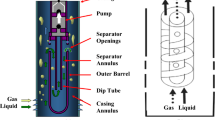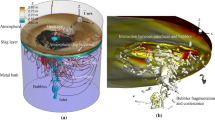Abstract
Axial gas–liquid separators have been adopted in fission gas removal systems for the development of thorium molten salt reactors. In our previous study, we observed an unsteady flow phenomenon in which the flow pattern is directly dependent on the backpressure in a gas–liquid separator; however, the underlying flow mechanism is still unknown. In order to move a step further in clarifying how the flow pattern evolves with a variation in backpressure, a large eddy simulation (LES) was adopted to study the flow field evolution. In the simulation, an artificial boundary was applied at the separator outlet under the assumption that the backpressure increases linearly. The numerical results indicate that the unsteady flow feature is captured by the LES approach, and the flow transition is mainly due to the axial velocity profile redistribution induced by the backpressure variation. With the increase in backpressure, the axial velocity near the downstream orifice transits from negative to positive. This change in the axial velocity sign forces the unstable spiral vortex to become a stable rectilinear vortex.










Similar content being viewed by others
Abbreviations
- P out :
-
Backpressure
- Re :
-
Reynolds number
- r*:
-
Non-dimensional radial coordinates r* = r/R
- S :
-
Swirl number
- t :
-
Time
- t*:
-
Non-dimensional time
- T :
-
Total time of flow evolution
- V in :
-
Average velocity at separator inlet
- \( v_{\text{a}}^{*} \) :
-
Non-dimensional axial velocity \( v_{\text{a}}^{ *}\,{ = }\,{{v_{\text{a}} } \mathord{\left/ {\vphantom {{v_{\text{a}} } {V_{\text{in}} }}} \right. \kern-0pt} {V_{\text{in}} }} \)
- \( v_{\text{t}}^{*} \) :
-
Non-dimensional tangential velocity \( v_{\text{t}}^{ *}\,{ = }\,{{v_{\text{t}} } \mathord{\left/ {\vphantom {{v_{\text{t}} } {V_{\text{in}} }}} \right. \kern-0pt} {V_{\text{in}} }} \)
References
J. Yin, J. Li, Y. Ma et al., Study on the air core formation of a gas–liquid separator. J. Fluid. Eng. T. ASME. 137, 91301 (2015). https://doi.org/10.1115/1.4030198
J. Yin, Y. Ma, Y. Qian et al., Experimental investigation of the bubble separation route for an axial gas–liquid separator for TMSR. Ann. Nucl. Energy 97, 1–6 (2016). https://doi.org/10.1016/j.anucene.2016.06.018
N. Syred, A review of oscillation mechanisms and the role of the precessing vortex core (PVC) in swirl combustion systems. Prog. Energy Combust. 32, 93–161 (2006). https://doi.org/10.1016/j.pecs.2005.10.002
D. Durox, J.P. Moeck, J. Bourgouin et al., Flame dynamics of a variable swirl number system and instability control. Combust. Flame 160, 1729–1742 (2013). https://doi.org/10.1016/j.combustflame.2013.03.004
G.I. Pisarev, V. Gjerde, B.V. Balakin et al., Experimental and computational study of the “end of the vortex” phenomenon in reverse-flow centrifugal separators. AIChE J. 58, 1371–1380 (2012). https://doi.org/10.1002/aic.12695
J.L. Yin, L. Jiao, L. Wang, Large eddy simulation of unsteady flow in vortex diode. Nucl. Eng. Des. 240, 970–974 (2010). https://doi.org/10.1016/j.nucengdes.2010.01.010
S.I. Shtork, N.F. Vieira, E.C. Fernandes, On the identification of helical instabilities in a reacting swirling flow. Fuel 87, 2314–2321 (2008). https://doi.org/10.1016/j.fuel.2007.10.016
R. Hreiz, C. Gentric, N. Midoux et al., Hydrodynamics and velocity measurements in gas-liquid swirling flows in cylindrical cyclones. Chem. Eng. Res. Des. 92, 2231–2246 (2014). https://doi.org/10.1016/j.cherd.2014.02.029
S.V. Alekseenko, P.A. Kuibin, V.L. Okulov et al., Helical vortices in swirl flow. J. Fluid Mech. 382, 195–243 (1999). https://doi.org/10.1017/S0022112098003772
S. Ragab, M. Sreedhar, Numerical simulation of vortices with axial velocity deficits. Phys. Fluids 7, 549–558 (1995). https://doi.org/10.1063/1.868582
O. Lucca-Negro, T. O’Doherty, Vortex breakdown: a review. Prog. Energy Combust. 27, 431–481 (2001). https://doi.org/10.1016/S0360-1285(00)00022-8
J.L. Yin, J.J. Li, Y.F. Ma et al., Numerical approach on the performance prediction of a gas–liquid separator for TMSR. J. Nucl. Sci. Technol. (2015). https://doi.org/10.1080/00223131.2015.1092399
B.C. Cai, J.J. Wang, L.C. Sun et al., Experimental study and numerical optimization on a vane-type separator for bubble separation in TMSR. Prog. Nucl. Energy 74, 1–13 (2014). https://doi.org/10.1016/j.pnucene.2014.02.007
Y. Xu, X. Song, Z. Sun et al., Numerical investigation of the effect of the ratio of the vortex-finder diameter to the spigot diameter on the steady state of the air core in a hydrocyclone. Ind. Eng. Chem. Res. 52, 5470–5478 (2013). https://doi.org/10.1021/ie302081v
M. Narasimha, A.N. Mainza, P.N. Holtham et al., Air-core modelling for hydrocyclones operating with solids. Int. J. Miner. Process. 102, 19–24 (2012). https://doi.org/10.1016/j.minpro.2011.09.004
R. Hreiz, C. Gentric, N. Midoux, Numerical investigation of swirling flow in cylindrical cyclones. Chem. Eng. Res. Des. 89, 2521–2539 (2011). https://doi.org/10.1016/j.cherd.2011.05.001
M. Germano, U. Piomelli, P. Moin et al., A dynamic subgrid-scale eddy viscosity model. Phys. Fluids Fluid Dyn. 3, 1760–1765 (1991). https://doi.org/10.1063/1.857955
A. Favrel, A. Mueller, C. Landry et al., Study of the vortex-induced pressure excitation source in a Francis turbine draft tube by particle image velocimetry. Exp. Fluids 56, 1–15 (2015). https://doi.org/10.1007/s00348-015-2085-5
Author information
Authors and Affiliations
Corresponding author
Additional information
This work was supported by the National Natural Science Foundation of China (Nos. 11535009 and 51406114).
Rights and permissions
About this article
Cite this article
Li, JJ., Qian, YL., Yin, JL. et al. Large eddy simulation of unsteady flow in gas–liquid separator applied in thorium molten salt reactor. NUCL SCI TECH 29, 62 (2018). https://doi.org/10.1007/s41365-018-0411-3
Received:
Revised:
Accepted:
Published:
DOI: https://doi.org/10.1007/s41365-018-0411-3




